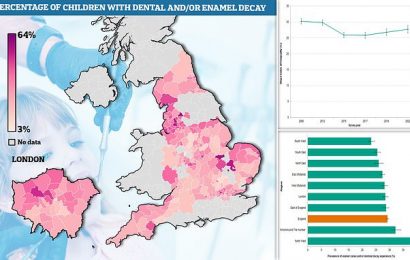When Jennifer Lucier and her husband found out they were expecting a baby in 2016, they immediately made three phone calls.
The first was to her mother. The second was to her husband’s family. And the third was to the Roper St. Francis Healthcare Learning Center.
That last call, she felt, was particularly urgent. Lucier wanted to secure a spot for her unborn infant on the day care’s long waiting list.
Lucier works as a cardiovascular ICU nurse for Roper St. Francis Healthcare, the only hospital system around Charleston, South Carolina, that operates a child care center for the children of its employees.
The catch is there isn’t room for everyone. Roper St. Francis employs 5,000 people, and its day care can accommodate only 130 infants and children. More than 100 children typically sit on that waiting list. Lucier’s newborn was 9 months old before an opening became available.
“We were ecstatic,” said Lucier, who also gave birth to twins in 2020. Her children are still enrolled in the Learning Center.
Roper St. Francis Healthcare opened the facility more than 30 years ago to address a perennial human resources problem: recruitment and retention. Today, it remains one of the relatively few hospital systems in the United States to operate a full-time child care center for its employees, though that appears to be changing. Some hospitals are now considering child care centers as a means of solving one of the pandemic era’s big challenges: persuading employees to stay.
Nationally, only about 1 in 10 workers have access to employer programs that cover some or all of the costs for child care services — either on the job site or off — according to a report published last year by the U.S. Department of Labor. The health sector seems to be doing more: About one-third of U.S. hospitals offer child care benefits.
But the data obscures the wide variation of those benefits. Some hospitals provide access only to backup care so parents can make last-minute arrangements for sick children. Even among hospitals that offer more robust benefits, many parents, like Lucier, end up spending time on a waiting list.
Hospitals scrambled at the beginning of the pandemic to accommodate clinical staff members who suddenly found themselves unable to both work and care for their kids. More than two years later, most do not offer permanent solutions for parents facing the country’s ongoing child care crisis. Meanwhile, thousands of child care providers, ranging from small, at-home programs to large day care facilities, have closed since early 2020, making it even more difficult for families to secure care than it was for Lucier when she first gave birth.
These challenges are felt across all business sectors. A benefits report published by Care.com this year estimated that at least 4 million U.S. workers resigned each month during the second half of 2021, nearly half of them citing that they were struggling with child care or senior care challenges.
But retention has become a particularly urgent issue when it comes to nurses, who are overwhelmingly women and who have resigned from hospitals in huge numbers during the pandemic, citing burnout, stressful working conditions, and other workplace problems. In fact, the number of registered nurses in the U.S. dropped by more than 100,000 last year — “a far greater drop than ever observed over the past four decades,” according to a report published by Health Affairs. In a recent McKinsey & Co. survey involving hundreds of nurses, 32% indicated they may leave their current position within the next year.
“People are leaving the industry because they’re not able to balance work and life,” said Priya Krishnan, senior vice president of client relations for Bright Horizons, the largest provider of employer-sponsored child care in the country.
Bright Horizons operates 82 hospital-based child care centers out of 655 centers it runs across the country. Krishnan said most of the recent conversations the company is having with potential clients have been with hospitals.
“Retention is the biggest reason they’re thinking about this,” she said.
The federal government offers businesses an annual tax credit worth up to $150,000 for providing child care to employees. Indirect financial incentives also exist. According to the 2022 “National Health Care Retention & RN Staffing Report” published by NSI Nursing Solutions, hospitals lose an average of about $46,000 when a bedside nurse resigns, which equaled about $7 million in nursing turnover costs for the average hospital in 2021.
But anecdotal evidence offered by Roper St. Francis suggests that employees whose children are enrolled in the Learning Center are much less likely to leave. The system experienced significant turnover during the pandemic, said Melanie Stith, its vice president for human resources. But during that time, she said, only two employees whose children attended the Learning Center resigned.
In a recent survey of parents who use the Learning Center, 91% indicated that the child care facility was the reason they remained in their jobs. Roper St. Francis loses money operating the Learning Center, but it’s still considering an expansion of child care services as it builds a bigger hospital in nearby Berkeley County.
That’s not to say, historically, that money hasn’t been made in child care. Bright Horizons, founded in the 1980s with an investment from Bain Capital, made hundreds of millions of dollars for the private equity firm. Now publicly traded, its shares are worth about half what they were at the peak of their value in February of last year.
Some hospitals still consider child care a good investment.
“I look at this as being a really, really vital piece of the benefits package, especially for families with kids who are infants to school-age,” said Rebecca Gomez, a clinical health psychologist at Wellstar Health System, based in the Atlanta area. Both of her children are enrolled in Wellstar’s Learning Academy operated by Bright Horizons.
“Everything about it has made my life so much easier,” Gomez said.
As with the Roper St. Francis Healthcare Learning Center in Charleston, Wellstar employees often end up waiting for an available spot. And Wellstar doesn’t operate child care facilities on every hospital campus, Gomez said.
Even so, the breadth of Wellstar’s child care offerings makes it an outlier. Other notable examples include Mass General Brigham in Boston and NewYork-Presbyterian, both of which have long offered child care for employees. And while providing on-site child care remains rare, hospitals are increasingly exploring options for it.
Ballad Health — a hospital system with medical facilities in Appalachian Tennessee, Virginia, and North Carolina — recently announced it will invest $37 million over the next three years to build 11 child care centers, in addition to the three it already operates. The expansion will allow the system based in Johnson City, Tennessee, to increase its child care capacity from 200 slots to 2,000.
For employees, hospital-based child care isn’t typically free. Roper St. Francis Healthcare in Charleston charges all parents who use the Learning Center a weekly rate, ranging from $200 to $220, based on the age of the child, slightly higher than the market average.
Some hospital systems create a sliding scale that takes into consideration the employee’s salary. A doctor, for example, might pay more than an X-ray tech to enroll a child. Ballad Health recently polled employees, who indicated, on average, they could afford to pay about $145 per child per week.
Like many hospital systems, Ballad has struggled to keep nurses from leaving during the pandemic. But it’s also competing with other regional employers for jobs. Tony Keck, executive vice president of system innovation at Ballad Health, said a new casino in Bristol, Virginia, recently hired 600 people. It’s expected over the next few years to hire thousands more, he said.
“We’re not just competing for doctors and nurses,” Keck said. The hospital also needs to attract housekeeping staff and other lower-wage workers whom the casino and others are targeting.
But nurses are particularly crucial. Keck said Ballad Health raised its starting nursing salary by more than 30% over the past two years, but hospitals in nearby markets such as Knoxville — which paid nurses higher salaries to begin with — raised their rates, too.
“We can’t keep up with that,” he said. Ballad Health leaders hope the new child care centers will offer the system a competitive advantage, “which is why we’re trying to move as quickly as possible,” he said.
Source: Read Full Article


